The sequence of images below provides details for RO membrane replacement in typical reverse osmosis systems. When you order a replacement membrane from us, you will receive the membrane only, not the entire pressure vessel.
To see animated representations of membrane replacement, please review the Installation & Maintenance animation appropriate for your BEV system. (Use the links in the column on the left.)
Replacement membranes for your system can be ordered via the Replacement Parts pages under the Product category above.
NOTE: It is important to recognize while all membranes have similar construction, not all are capable of producing BEV quality water. If you want to insure your system will meet BEV standards for purity and biocompatibility, you will need to use our membranes which have been tested to conform to BEV standards. Use of non-PWS® parts will void your lifetime warranty.
If replacing the membrane is something you are uncomfortable with, we can provide a complete replacement package consisting of membrane, pressure vessel, and fittings for a nominal upcharge. Call our toll-free number 866.444.9926 for assistance.
To the right is a reverse osmosis pressure vessel (ROPV). Almost all ropv's for residential use share the same common design—one end has a threaded cap with an inlet port, the other end has two outlets, one for purified water and one for brine water.
PWS® BEV systems have used two different pressure vessels over the years. Initially our vessel looked just like the one shown to the right. Later we switched to a 100% polypropylene that has a smooth end cap (compared to the one shown with ridges on the end cap.) We have switched back to the one shown once or twice due to limited availability.
NOTE: The brine port is the one offset from center. |
 |
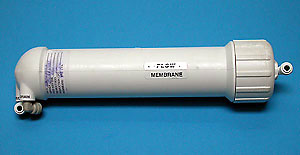 Reverse Osmosis Pressure Vessel
Reverse Osmosis Pressure Vessel
|
|
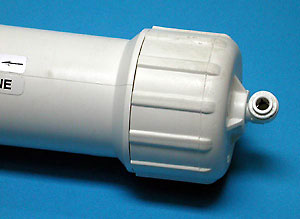 Vessel End Cap and Inlet Port
Vessel End Cap and Inlet Port
|
 |
Here's a close-up of the threaded cap and inlet port.
This vessel has John Guest Speedfit® fittings threaded into the ports. In some older systems, brass fittings were used instead.
If you have one of the older designs let us know and we'll include new fittings with your replacement membrane.
|
|
To the right is a close-up view of the outlet ports with John Guest Speedfit® fittings attached.
|
 |
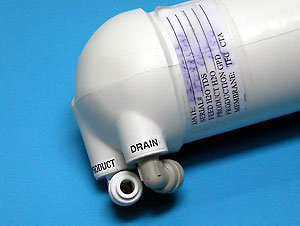 Vessel Outlet Ports
Vessel Outlet Ports
|
|
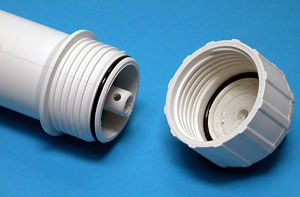 Cap Removed Exposing RO Membrane
Cap Removed Exposing RO Membrane
|
 |
View of the pressure vessel with the end cap removed. You can just see the end of the reverse osmosis membrane protruding from inside the vessel.
Note this pressure vessel end cap has two O-ring seals. If you have one of our polypropylene vessels with the smooth end cap there is a single O-ring. (see below)
Pressure vessels for residential use are usually designed to withstand 100 psi.
To ensure a good seal, it is a good idea to wipe the O-rings with a little bit of Vaseline®—a thin film is all that is necessary. |
|
Here the reverse osmosis membrane has been pulled partially out of the vessel. Membranes seat quite firmly inside the vessel, and it may take a pair of pliers to wiggle it free.
When installing the new membrane, just center it and push it firmly into the pressure vessel. If the membrane protrudes much more than in the image above, re-center it so it can slide into the seat at the other end of the vessel. |
 |
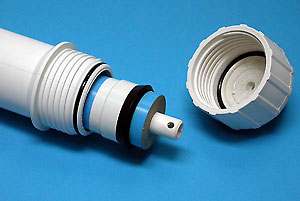 Cap Removed Exposing RO Membrane
Cap Removed Exposing RO Membrane
|
|
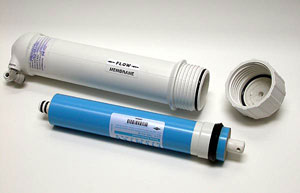 Pressure Vessel with RO Membrane Removed
Pressure Vessel with RO Membrane Removed |
 |
In this image, you can see the reverse osmosis membrane has been completely removed from the pressure vessel.
|
|
|
The smooth capped pressure vessel we use (compared to the ribbed cap above) utilizes a single O-ring (shown right) to seal the vessel.
You can also see how far down into the vessel the reverse osmosis membrane is seated. The membrane must be manually inserted fully into the vessel—the end cap does not force the membrane into position, it must be fully seated before replacing the end-cap.
|
 |
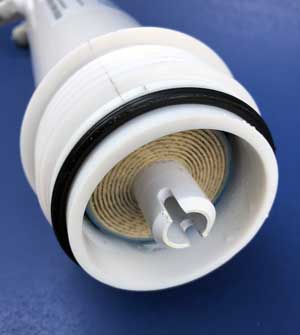 Cap Removed showing O-ring placement
Cap Removed showing O-ring placement
|
|


Ultra Pure BEV Drinking Water
by pure water systems, inc.
866.444.9926
www.purewatersystems.com
©2019 Pure Water Systems, Inc. All rights reserved.


















